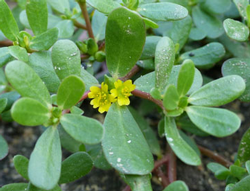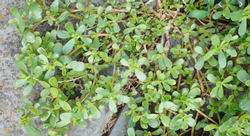Purslane, Weed It or Eat It
By Sandy Wood 2014

It is considered quite nutritious because it is unusually high in omega-3 fatty acids and contains significant amounts of vitamins A and C, as well as calcium, iron, magnesium and potassium and antioxidants. It also contains high amounts of oxalates so should not be consumed excessively by those susceptible to forming kidney stones. It is sometimes used as fodder and is fed to poultry to reduce egg cholesterol and was also used traditionally as an ointment for burns. Some other common names include garden purslane, little hogweed, pusley, and wild portulaca. It’s called pourpierin France and verdolagain Mexico.

The mature plant grows prostrate to spreading, up to 3-1/3 ft (1 m) in length, and has many succulent branches, starting from the base. Leaves are egg to spatula-shaped, succulent, stalkless or have very short stalks, about 1/5 inches to 1-1/5 inches (5–30 mm) long, and sometimes their edges are red-tinged. Leaves are arranged either opposite one another or alternate along the stem.
Flowering takes place from May through September. Single flowers or clusters of two to five, are found at stem tips. The flowers are small, yellow, usually have five petals, and typically open only on hot, sunny days from midmorning to early afternoon. Plants reproduce by seeds.
Learn more interesting and scientific discussions on health benefits and herbal usage from the National Center for Biotechnology Information.
The stems, leaves, and flower buds have a slightly tart or sour and salty taste. The intensity of flavor is influenced by the physiology of the plant. In hot, dry conditions purslane switches to photosynthesis using Crassulacean acid metabolism (C4) as a means of conserving moisture. In this system, the leaves trap carbon dioxide at night (instead of during the day as with normal photosynthetic process, when open stomata would allow valuable water to escape through transpiration) and convert this to malic acid. Then the malic acid, which has a sour flavor, is converted to glucose for storage during the day. So leaves picked early in the day when malic acid concentrations are highest will have the tartest flavor. There are several named cultivars that are grown as crops, but few are available in the US.
For those of you that are interested in trying a recipe, there are many to choose –from Mexican to Turkish. Try Google and pick one that may appeal to you or you can do what I do and just toss a few leaves in a salad and enjoy.
Source Material:
https://wimastergardener.org/article/common-purslane-portulaca-oleracea/
http://sonomamg.ucanr.edu/The_Kitchen_Garden/Feature_Vegetables/Purslane/
http://ipm.ucanr.edu/PMG/WEEDS/purslane.html
https://www.ncbi.nlm.nih.gov/pmc/articles/PMC393476

